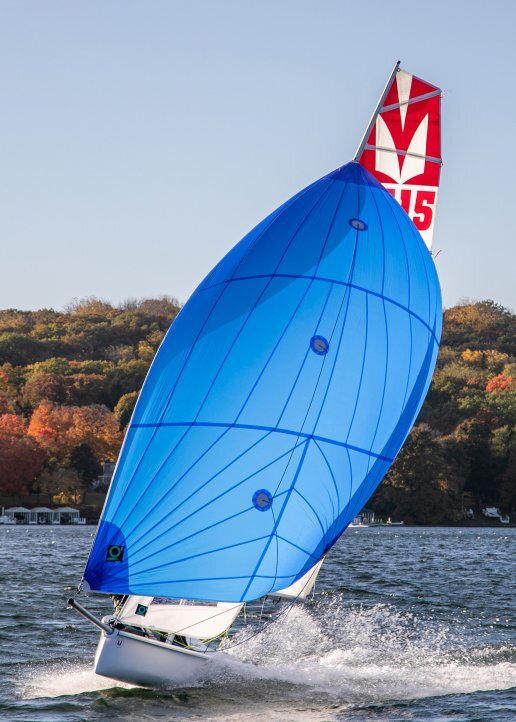If you look at the Melges 15 spinnaker, you will notice 3 patches down the center. These three patches contain holes where the dousing line is threaded through then threaded down the spinnaker bag on the deck. Instead of other boats where you would have to release the spinnaker halyard then frantically grab and pull armfuls of spinnaker material in during a douse, the Melges 15 design allows you to release then pack the spinnaker away neatly in a bag all by pulling on a single line—a very clean and simple process. The dousing line design is one of the Melges 15 features that adds to the boat’s user friendly characteristic.
There are three spinnaker douses that every Melges 15 sailor should learn and master—the Windward, Mexican, and Leeward douse. Read the step by step guide on performing these three douses below.
Windward Douse
First the skipper will bare away from the wind slightly. This will keep the boat flat, so the crew can start moving around inboard.
The crew will move to the middle of the boat to grab the spinnaker douser line.
The crew should pull all the slack out of the douser line with one hand while they keep their other hand trimming the spinnaker sheet.
Once the slack is out of the douser line, you’re ready to go and the skipper can call for the douse.
The crew will release the spinnaker sheet—so the spinnaker is simply free flying—and use the now free hand to release the spinnaker halyard. During this the skipper should bare away a little more—this will allow the spinnaker to come onto the weather side of the head stay where it can be pulled into the spinnaker bag more cleanly.
The crew will pull in the douser line as fast as they can to pull down the spinnaker into its bag.
Once the spinnaker is fully in its bag, the skipper can then head back up while the crew trims the jib sheet to transition back to upwind sailing.
Mexican Douse
A Mexican douse is when a boat douses its spinnaker and does a gybe at the same time. Fancy huh?
The skipper will bare away to flatten the boat so the crew can move into the boat.
The crew will trim the spinnaker in with one hand and then grab and take the slack out of the douser line with the other.
Once the slack is out of the douser line, the skipper can start the gybe.
Both skipper and crew will maneuver to the other side of the boat.
Once on the new side, the crew will release the spinnaker halyard and start pulling hard on the douse line to bring the spinnaker down and into its bag. During this the skipper should keep the boat at a deeper angle to help the spinnaker come down easier.
Once the spinnaker is fully in its bag, the skipper can head back up into the wind and trim the main while the crew trims in the jib.
Leeward Douse
The skipper will bare away to flatten the boat so the crew may move into the boat.
The crew will grab the douser line and pull all of the slack out.
The skipper will call for the douse.
The crew will then release first the spinnaker sheet and then the spinnaker halyard.
The crew then pulls hard on the douser line to bring the spinnaker into its bag. During this the skipper should bare away from the wind to allow the spinnaker to come back in.
Once the spinnaker is fully in its bag, the skipper can straighten out the heading and trim the main while the crew trims in the jib.
Dousing Tips & Tricks
Always make sure your spinnaker is pulled fully into your spinnaker bag when dousing. If too much of the spinnaker is left out, the wind can catch the exposed sail and pull the spinnaker back out of the bag.
Skippers should keep the boat angled far enough down during the douse. If the boat is too far up, too much wind will stay in the sail. The crew will then struggle to pull in a full sail. Worse yet, the spinnaker could fall into the water. Skippers can even head dead down wind to take all of the wind pressure off of the sail.
Watch the dousing guide video from Melges Performance Sailboat’s Eddie Cox:
Want to learn more about the M15? Want to demo an M15? Contact Richard Allen or 180 Marine—authorized Rocky Mountain Melges Dealer for Melges 14, 15, 20, and 24 at richard@180marine.com.



